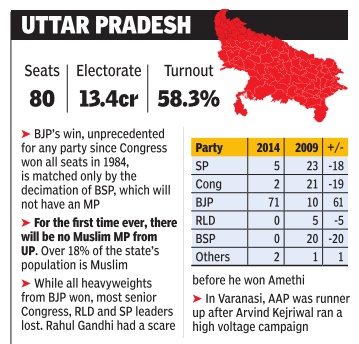Uttar Pradesh: Parliamentary elections
This is a collection of articles archived for the excellence of their content. |
2014
2009, 2014
71/80: BJP posts its best-ever show in UP
Lucknow: TEAM TOI
The Times of India May 17 2014
SP Has Five Winners, All From Mulayam's Family; Not A Single Muslim MP From State
What L K Adva ni's rath yatra couldn't achieve in the 1990s, Narendra Modi's juggernaut has done in UP in 2014: a near-total decimation of the entire opposition with 71 out of 80 seats and 42% vote share for BJP. It's the maximum the party has ever got. The decisive verdict, however, has a flipside: UP hasn't sent any Muslim MP to the Lok Sabha this time. In 2009, SP had won 23, Congres 21, BSP 20 and BJP just 10.
The saffron domination was total: it left just five seats for SP and two for Congres, while BSP failed to open its account. The remaining two seats went to Apna Dal, a part of the NDA.
All SP seats went to the Yadav family: Mulayam, who won from two seats, daughter-in-law Dimple and nephews Dharmendra and Aksh ay. The two Congres winners were Sonia and Rahul Gandhi from Rae Bareli and Amethi.
RLD's father-son duo Ajit Singh and Jayant Chaudhary lost. All six Congres ministers, including Salman Khurshid, Beni Prasad Verma, Sri Prakash Jaiswal and RPN Singh, were defeated by huge margins.
The wave was neither as strong as the post-Emergency 1977 elections, when Congres got zilch with even Indira Gandhi defeated, nor as powerful as 1984, when Congres swept the entire state with just Lok Dal getting two seats. However, it was much stronger than the Ram temple wave which gave the party 57 seats in 1998.
First-time voters', youth and women's voting percentage was higher this time than those in 2009. SP's vote share of 22.3%, BSP's 19.8% and Congres's 7.4% did not translate into seats. In 1996, with a similar vote share (20.84%), SP had won 16 seats and BSP (20.61%) six. This time, besides promoting the development rhetoric and the Gujarat model, Modi also projected himself as a man of `neech jati' and was able to beat SP and BSP in their own game by combining `mandal' (caste) and `kamandal' (communalism).
Apart from contesting from UP to project his acceptability across the country , Modi addressed over 60 rallies covering all the 80 constituencies in eight months.
The high-voltage campaign through electronic, print and social media was meticulously supplemented by the powerful whisper campaign by Sangh Parivar foot soldiers in each and every village across the state.
By describing Congres, BSP, SP and RLD as members of a team which indulges in shadow boxing in the state but shares a table at the Centre, Modi made the majority of the electorate believe that the opposition survives on Muslim vote-bank politics and are responsible for the poor state of affairs. And then, Modi deftly projected himself as a man with solution to the problems. His rivals had no answer to his call, “Achhe din aane wale hain“.
In the Rohilkhand region, the saffron outfit won Bareilly, Aonla, Pilibhit, Moradabad, Nagina and Shahjahanpur while rival SP managed to retain the Badaun seat.
Dharmendra Yadav turned out to be the only face-saver of SP in Badaun, a Yadav stronghold.
In Bareilly , six-time MP and BJP candidate Santosh Kumar Gangwar gave a drubbing to SP's Ayesha Islam by a margin of more than 2.40 lakh votes.
In Pilibhit, BJP's Maneka Gandhi also led from the front, and won by three lakh votes over her nearest rival, surpassing the victory margin of her son and sitting MP Varun Gandhi, who had won from Pilibhit with a margin of 2.81 lakh in 2009.
